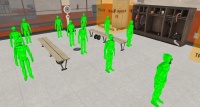info_player_teamspawn
Jump to navigation
Jump to search

 Warning:If you have ANY team_control_point_round entities in your map, you MUST also set the '<team> spawn for round' settings below. If this is not done both teams will spawn at all spawn points.
Warning:If you have ANY team_control_point_round entities in your map, you MUST also set the '<team> spawn for round' settings below. If this is not done both teams will spawn at all spawn points.
 Note:Make sure to raise the
Note:Make sure to raise the
 Note:The entity must be at least 1 unit above any surface.
Note:The entity must be at least 1 unit above any surface.
| CTeamSpawnPoint |
info_player_teamspawn is a point entity available in all ![]() Source games except
Source games except ![]() Alien Swarm.
Alien Swarm.
This entity marks the spawn point for Team Fortress 2 players.
A standard map should have at least 16 spawnpoints per respawn room, to account for a normal maximum team size on a server with the maximum player count raised to the maximum allowed value.
Keyvalues
- Name (targetname) <string>
- The name that other entities refer to this entity by, via Inputs/Outputs or other keyvalues (e.g.
parentnameortarget).
Also displayed in Hammer's 2D views and Entity Report. - See also: Generic Keyvalues, Inputs and Outputs available to all entities
TeamNum:
- Match Summary (MatchSummary) <choices>
- Determines whether this location is used for the match summary.
- 0 : Not Valid
- 1 : Loser
- 2 : Winner
- Associated Control Point (controlpoint) <string>
- The team_control_point associated with this spawn. Ownership of control points will control this spawn point's enabled state.
- Spawn Mod (SpawnMode) <choices>
- How the game decides when a player can spawn here. Triggered mode will only allow players sent via a trigger_player_respawn_override (in which case this spawn must be named, and match the trigger).
- 0 : Normal
- 1 : Triggered
- Blue spawn for round (round_bluespawn) <string>
- Blue spawn point when the associated round is being played.
- Red spawn for round (round_redspawn) <string>
- Red spawn point when the associated round is being played.
- Start Disabled (StartDisabled) <boolean>
- Stay dormant until activated (with the
Enableinput).
Flags
- Scout : [1]
- Sniper : [2]
- Soldier : [4]
- Demoman : [8]
- Medic : [16]
- Heavyweapons : [32]
- Pyro : [64]
- Spy : [128]
- Engineer : [256]
Inputs
EnableDisable:
- Enable / Disable
- Enable/disable this entity from performing its task. It might also disappear from view.
Notes
info_player_teamspawn entities at least 8-16 Hammer Units off the ground to ensure they function as they should.Must have a at least 32 units of space around it on all sides from other teamspawn entities or it will not work properly.
The entity basically searches for anything below its point origin and spawns players there. When flush with a surface, It looks for a valid spawnpoint under that brush. When it doesn't find one near it, it invalidates that spawnpoint.
